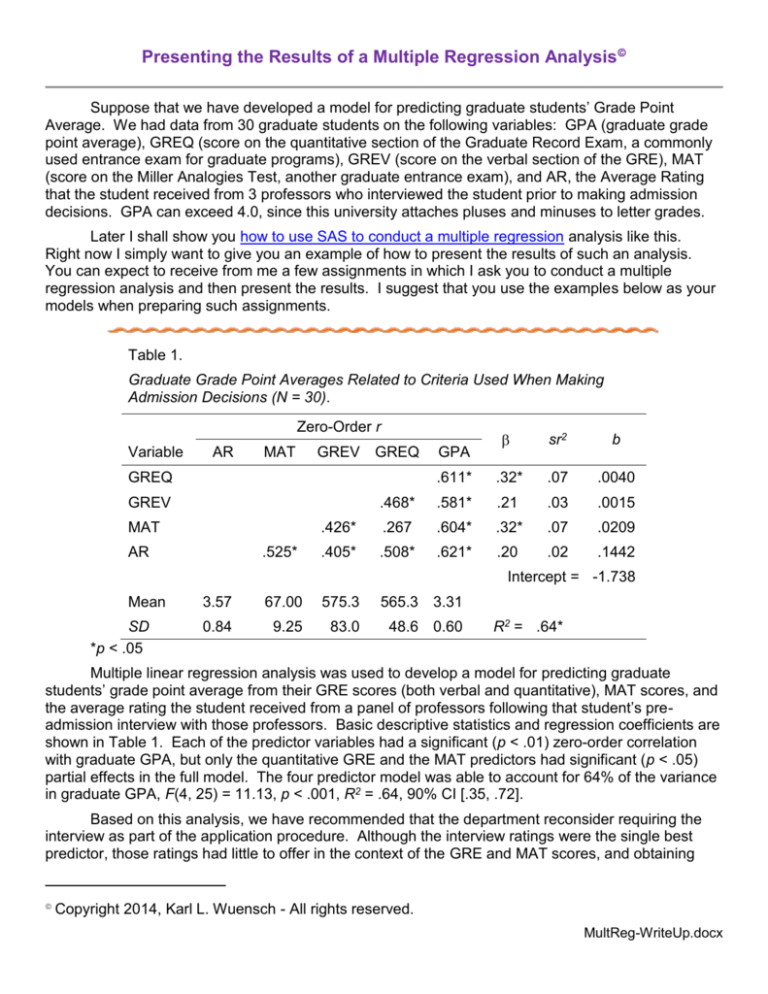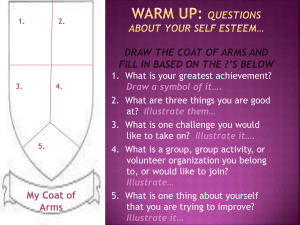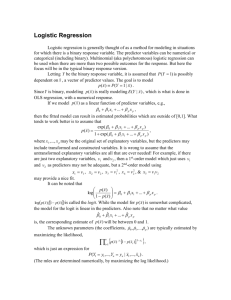
Presenting the Results of a Multiple Regression Analysis
Suppose that we have developed a model for predicting graduate students’ Grade Point
Average. We had data from 30 graduate students on the following variables: GPA (graduate grade
point average), GREQ (score on the quantitative section of the Graduate Record Exam, a commonly
used entrance exam for graduate programs), GREV (score on the verbal section of the GRE), MAT
(score on the Miller Analogies Test, another graduate entrance exam), and AR, the Average Rating
that the student received from 3 professors who interviewed the student prior to making admission
decisions. GPA can exceed 4.0, since this university attaches pluses and minuses to letter grades.
Later I shall show you how to use SAS to conduct a multiple regression analysis like this.
Right now I simply want to give you an example of how to present the results of such an analysis.
You can expect to receive from me a few assignments in which I ask you to conduct a multiple
regression analysis and then present the results. I suggest that you use the examples below as your
models when preparing such assignments.
Table 1.
Graduate Grade Point Averages Related to Criteria Used When Making
Admission Decisions (N = 30).
Zero-Order r
Variable
AR
MAT
sr2
b
.611*
.32*
.07
.0040
.468*
.581*
.21
.03
.0015
.426*
.267
.604*
.32*
.07
.0209
.405*
.508*
.621*
.20
.02
.1442
GREV
GREQ
GREQ
GREV
MAT
AR
.525*
GPA
Intercept = -1.738
Mean
SD
*p < .05
3.57
67.00
575.3
565.3 3.31
0.84
9.25
83.0
48.6 0.60
R2 = .64*
Multiple linear regression analysis was used to develop a model for predicting graduate
students’ grade point average from their GRE scores (both verbal and quantitative), MAT scores, and
the average rating the student received from a panel of professors following that student’s preadmission interview with those professors. Basic descriptive statistics and regression coefficients are
shown in Table 1. Each of the predictor variables had a significant (p < .01) zero-order correlation
with graduate GPA, but only the quantitative GRE and the MAT predictors had significant (p < .05)
partial effects in the full model. The four predictor model was able to account for 64% of the variance
in graduate GPA, F(4, 25) = 11.13, p < .001, R2 = .64, 90% CI [.35, .72].
Based on this analysis, we have recommended that the department reconsider requiring the
interview as part of the application procedure. Although the interview ratings were the single best
predictor, those ratings had little to offer in the context of the GRE and MAT scores, and obtaining
Copyright 2014, Karl L. Wuensch - All rights reserved.
MultReg-WriteUp.docx
those ratings is much more expensive than obtaining the standardized test scores. We recognize,
however, that the interview may provide the department with valuable information which is not
considered in the analysis reported here, such as information about the potential student’s research
interests. One must also consider that the students may gain valuable information about us during
the interview, information which may help the students better evaluate whether our program is really
the right one for them.
-----------------------------------------------------------------------------------------------------------In the table above, I have used asterisks to indicate which zero-order correlations and beta
weights are significant and to indicate that the multiple R is significant. I assume that the informed
reader will know that if a beta is significant then the semipartial r and the unstandardardized slope are
also significant. Providing the semipartials, unstandardized slopes, and intercept is optional, but
recommended in some cases – for example, when the predictors include dummy variables or
variables for which the unit of measure is intrinsically meaningful (such as pounds or inches), then
unstandardized slopes should be reported.
If there were more than four predictors, a table of this format would get too crowded. I would
probably first drop the column of semipartials, then either the column of standardized or
unstandardized regression coefficients. If necessary I would drop the zero-order correlation
coefficients between predictors, but not the zero-order correlation between each predictor and the
criterion variable.
Here is another example, this time with a sequential multiple regression analysis. Additional
analyses would follow those I presented here, but this should be enough to give you the basic idea.
Notice that I made clear which associations were positive and which were negative. This is not
necessary when all of the associations are positive (when someone tells us that X and Y are
correlated with Z we assume that the correlations are positive unless we are told otherwise).
Results
data1
Complete
were available for 389 participants. Basic descriptive statistics and values of
Cronbach alpha are shown in Table 1
Table 1
Basic Descriptive Statistics and Cronbach Alpha
Variable
M
SD
α
Subjective Well Being
24.06
5.65
.84
Positive Affect
36.41
5.67
.84
Negative Affect
20.72
5.57
.82
3.31
2.36
.66
Rosenberg Self Esteem
40.62
6.14
.86
Contingent Self Esteem
48.99
8.52
.84
Perceived Social Support
84.52
8.39
.91
Social Network Diversity
5.87
1.45
19.39
7.45
SJAS-Hard Driving/Competitive
Number of Persons in Social Network
1
Data available in Hoops.sav file on my SPSS Data Page. Intellectual property rights belong to Anne S. Hoops.
Three variables were transformed prior to analysis to reduce skewness. These included
Rosenberg self esteem (squared), perceived social support (exponentiated), and number of persons
in social network (log). Each outcome variable was significantly correlated with each other outcome
variable. Subjective well being was positively correlated with PANAS positive (r = .433) and
negatively correlated with PANAS negative (r = -.348). PANAS positive was negatively correlated
with PANAS negative (r = -.158). Correlations between the predictor variables are presented in Table
2.
Table 2
Correlations Between Predictor Variables
SJAS-HC
RSE
CSE
PSS
RSE
.231*
CSE
.025
-.446*
PSS
.195*
.465*
-.088
ND
.110*
.211*
-.057
.250*
NP
.100*
.215*
.076
.283
ND
.660*
*p .05
A sequential multiple regression analysis was employed to predict subjective well being. On
the first step SJAS-HC was entered into the model. It was significantly correlated with subjective well
being, as shown in Table 3. On the second step all of the remaining predictors were entered
simultaneously, resulting in a significant increase in R2, F(5, 382) = 48.79, p < .001. The full model R2
was significantly greater than zero, F(6, 382) = 42.49, p < .001, R2 = .40, 90% CI [.33, .45]. As shown
in Table 3, every predictor had a significant zero-order correlation with subjective self esteem. SJASHC did not have a significant partial effect in the full model, but Rosenberg self esteem, contingent
self esteem, perceived social support, and number of persons in social network did have significant
partial effects. Contingent self esteem functioned as a suppressor variable. When the other
predictors were ignored, contingent self esteem was negatively correlated with subjective well being,
but when the effects of the other predictors were controlled it was positively correlated with subjective
well being.
Pedagogical Note. In every table here, I have arranged to have the column of zero-order
correlation coefficients adjacent to the column of Beta weights. This makes it easier to detect the
presence of suppressor effects.
Table 3
Predicting Subjective Well Being
Predictor
SJAS-Hard Driving Competitive
r
95% CI for
-.035
.131*
.03, .23
Rosenberg Self Esteem
.561*
.596*
.53, .66
Contingent Self Esteem
.092*
-.161*
-.26, -.06
Perceived Social Support
.172*
.426*
.34, .50
.134*
.04, .23
.221*
.12, .31
Network Diversity
-.089
Number of Persons in Network
.107*
*p .05
Fair Use of this Document
Return to Wuensch’s Stats Lessons Page
Copyright 2014, Karl L. Wuensch - All rights reserved.





